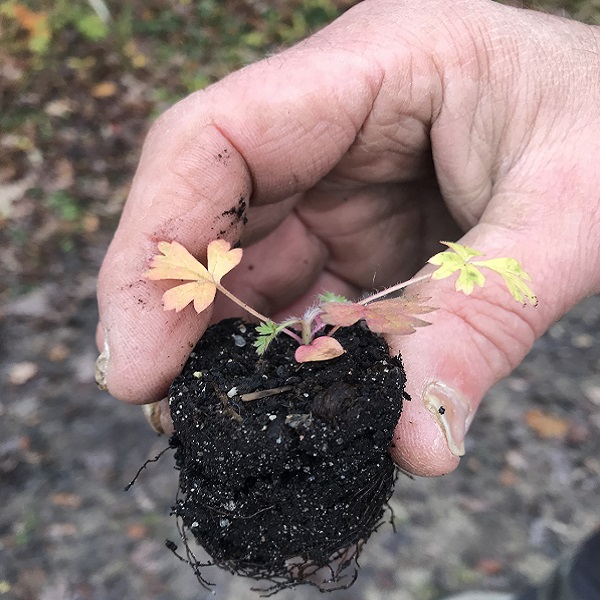 Credit: Georges Moes, natur&ëmwelt; John Park, Bee Together
Credit: Georges Moes, natur&ëmwelt; John Park, Bee Together
On Saturday 30 November 2019, natur&ëmwelt and a team of volunteers set out to improve the floral biodiversity in an important dry grassland in the Deiwelskopp nature reserve, located near Moersdorf in eastern Luxembourg.
Most of the actions carried out in the reserve formed part of the LIFE Orchis project that is funded by the European Commission and Luxembourg's Ministry of the Environment, Climate and Sustainable Development.
Some days before the event, natur&ëmwelt and Forum pour l'emploi prepared the site, scything the metre-high wild plants and clearing them to leave an open meadow. With the ground now accessible, they raked it to expose the soil where they would then plant. Their mission was to plant the seedlings of two rare species that were financed from donations: Carthusian Pink and European pasque flower.
Originally, the Deiwelskopp had only 1m2 of Carthusian Pink and another area of 300m2 of the European pasque flower, the only population in eastern Luxembourg. Over the years, natur&ëmwelt has purchased parcels of the dry grassland, such that there is now two hectares of open meadow where these plants could grow.
Permission required to collect seeds
natur&ëmwelt obtained permission from Germany to collect the seeds of Carthusian Pink, just over the border, which were then grown in pop-out seedling starter trays. They planted about 500 young seedlings in the shallow, rocky soil, particularly where the landscape slopes more steeply and where the ground is bare.
Seedlings were also grown from seeds from the European pasque flower, an endangered species in Luxembourg. In this case, the seeds were collected from the 150 plants in the Deiwelskopp in 2019 (permission likewise required). After Saturday’s planting, its population has doubled. The remaining 1,000 seedlings will be planted on other sites.
While the small, flat seedling looked unimpressive, this smart plant invests heavily in its root system as a means of establishing itself among its plant competitors in this rocky ground before investing in its aboveground shoot system.
One of the conditions of the permission given by the Ministry of the Environment, Climate and Sustainable Development to collect seeds and plant in the Deiwelskopp is that the plants are to be inventoried. With a GPS survey pole with a precision of 2cm locating the plant, the data will be contributed to the Data Portal of the Luxembourg National Museum of Natural History (MNHNL Data Portal). Using this localisation data, the plants’ development can be monitored over time, further contributing to scientific knowledge in Luxembourg.
A future project may be organised to increase the population of a similarly rare species, the European Michaelmas daisy.
The expected impact on the ecosystem
With the significant increase in flora biodiversity at the nature reserve, the likely increase in the number of flowers should attract more insects, including pollinators, and their predators, bats and birds, which rely heavily on the abundance of insects.
The pasque flower blooms in the early spring, hoping that it will be warm enough to waken the pollinators from their winter slumber and attract them to its flowers before other plants flower. A study of the pasque flower in Germany in October 2019 found that the flower attracted 53 wild bee species, with bumblebees and two genera of solitary bees accounting for nearly 50% of the visits.
With its tubular shaped flowers, Carthusian Pink is dependent on pollinators with long tubular mouthparts (proboscis). The flower is wholly dependent on day-flying butterflies and moths. A 2006 study identified five butterfly species that were the most important, of which two had the highest visitation rates that accounted for the flower’s pollination. Of the two butterflies, the marbled white is found in Luxembourg, including at the Deiwelskopp.
Since 2016, the butterflies on a specific path in the nature reserve are being identified and counted in June, July and August. The data is likewise contributed to the MNHNL Data Portal and the European Butterfly Monitoring Scheme (eBMS) to allow scientists to conduct research on the distribution and abundance of butterflies in Luxembourg.
To learn more about butterflies, their identification and how to contribute to collecting data, interested persons can register for the second course, taking place on 20 June 2020: https://www.eventbrite.com/e/bee-engaged-butterfly-identification-citizen-science-tickets-81363994899.









